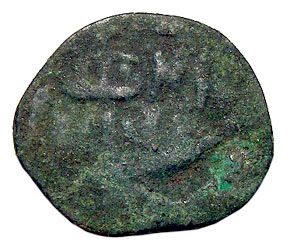Golden Horde Coins at the Medieval Market Site
Dima dug up a bronze coin of an oval shape too.

But it was not a Roman coin as it was thin and had Arabic letters.

Later we determined that it was in fact a Tartar-Mongolian coin minted during the rule of the Golden Horde.
1 Dirham, circa AD XIII - XV

Golden Horde Brief Historical Facts:
"In 1206, Genghis Khan proclaimed himself supreme ruler of all Mongols, a Tartar people to the north of China. Genghis Khan invaded China, captured Peking and then conquered an empire that reached from the Pacific to the Volga river. At his death, Genghis Khan divided the Mongol Empire amongst his sons, Batu, leader of the Blue Horde (Eastern), and Orda, leader of the White Horde (Western).
Batu Khan then succeeded in establishing control over his brother Orda's territorial endowment and conquered the region along the northern shore of the Black Sea, incorporating the Turkic peoples into his army. In the late 1230s and early 1240s, he conducted his brilliant campaigns against the Volga Bulgaria and against the successor states to Kievan Rus, bringing their ancient prosperity to an end. The rule of the Golden Horde was established in Russia in 1251. As a result, Russia experienced a cultural decay and isolation from Europe. Nearly all Russia became tributary to the Golden Horde for over two hundred years. The people of the Golden Horde were a mixture of Turks and Mongols. The Horde's supreme ruler was the khan chosen among Batu Khan's descendants.
The Mongol armies also raided Poland and Hungary. Batu Khan turned back from his siege of Vienna when the Great Khan Ogedei died in Mongolia in 1241, and the Mongol armies would never again travel so far west.
The Horde developed as a settled rather than nomadic culture. In 1242, Batu established his capital at Sarai at the lower stretch of the Volga River. Sarai evolved into a populous and prosperous metropolis. In the early 14th century, the capital became one of the largest cities of the medieval world, with 600,000 inhabitants. The Mongols clung to their traditional shamanist beliefs until Uzbeg Khan (1312-41) adopted Islam as a state religion. The territories of Christian subjects were regarded as peripheral areas of little interest as long as they continued to pay tribute. To maintain control over Russia, Tatar warlords carried out regular punitive raids to Russian principalities (most dangerous in 1252, 1293, 1382).
In the 1340s the empire fell into a long civil war, averaging one new Khan per
annum for the next few decades. Tokhtamysh, a descendant of Orda Khan and ruler
of the White Horde, tried to restore the dominance of the Golden Horde over Russia
by attacking Russian lands in 1382. He destroyed Moscow, killing 24,000 people.
In the 1440s, the Horde was again wrecked by civil war. This time it broke up
into eight separate Khanates (provinces): Siberia Khanate, Qasim Khanate, Khanate
of Kazan, Khanate of Astrakhan, Kazakh Khanate, Uzbek Khanate, and Khanate of
Crimea.
None of these new Khanates was stronger than Muscovite Russia
which finally brought the final death knell to the Golden Horde by defeating it
in 1480. Each Khanate was eventually annexed by Russia, starting with Kazan and
Astrakhan in the 1550s. By the end of the century the Siberia Khanate was also
part of Russia.
The Crimean Khanate became a vassal state of the Ottoman Empire in 1475 and conquered what remained of the Golden Horde by 1502. Under Ottoman protection, the Khanate of Crimea continued its existence until Catherine
the Great annexed it on April 8, 1783. It was by far the longest-lived of the
successor states to the Golden Horde.
When the Kievan Rus was crashed
in the middle of the 13th century, monetary circulation in the territory of the
Kievan Rus - Ukraine was dead. Mongol silver dirhams and copper coins were in
circulation in the southern lands of the Ukraine which were included into the
Golden Horde.
Crimean Khanat arose from the ruins of Golden Horde in
the south of the Ukraine which started its own coinage on behalf of dynasty of
khans Gireys. Autonomous Genoese-Tatar town Kaffa (now is Theodosiya), formed
in the Crimea in the middle of the 15th century, also issued its own silver and
copper coins."
We continued our search until very late at night when we stopped getting any signals. At last, this metal detecting outing was satisfactory, and it marked the end of a bad spell of "fruitless" metal detecting for us. From now on, our efforts would be rewarded!